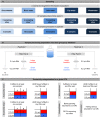Phylogenetic clustering of small low nucleic acid-content bacteria across diverse freshwater ecosystems
- PMID: 29416124
- PMCID: PMC5932017
- DOI: 10.1038/s41396-018-0070-8
Phylogenetic clustering of small low nucleic acid-content bacteria across diverse freshwater ecosystems
Abstract
Here we used flow cytometry (FCM) and filtration paired with amplicon sequencing to determine the abundance and composition of small low nucleic acid (LNA)-content bacteria in a variety of freshwater ecosystems. We found that FCM clusters associated with LNA-content bacteria were ubiquitous across several ecosystems, varying from 50 to 90% of aquatic bacteria. Using filter-size separation, we separated small LNA-content bacteria (passing 0.4 µm filter) from large bacteria (captured on 0.4 µm filter) and characterized communities with 16S amplicon sequencing. Small and large bacteria each represented different sub-communities within the ecosystems' community. Moreover, we were able to identify individual operational taxonomical units (OTUs) that appeared exclusively with small bacteria (434 OTUs) or exclusively with large bacteria (441 OTUs). Surprisingly, these exclusive OTUs clustered at the phylum level, with many OTUs appearing exclusively with small bacteria identified as candidate phyla (i.e. lacking cultured representatives) and symbionts. We propose that LNA-content bacteria observed with FCM encompass several previously characterized categories of bacteria (ultramicrobacteria, ultra-small bacteria, candidate phyla radiation) that share many traits including small size and metabolic dependencies on other microorganisms.
Conflict of interest statement
The authors declare that they have no conflict of interest.
Figures







References
-
- Schulz HN, Brinkhoff T, Ferdelman TG, Mariné MH, Teske A, Jørgensen BB. Dense populations of a giant sulfur bacterium in namibian shelf sediments. Science (80-). 1999;284.. - PubMed
Publication types
MeSH terms
Substances
LinkOut - more resources
Full Text Sources
Other Literature Sources

